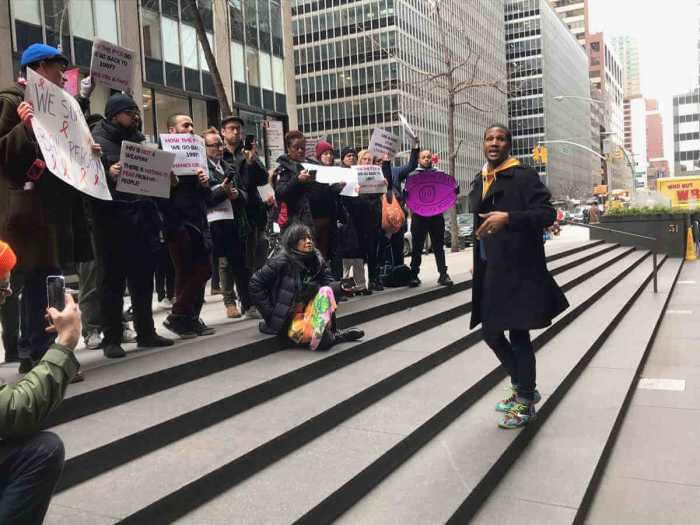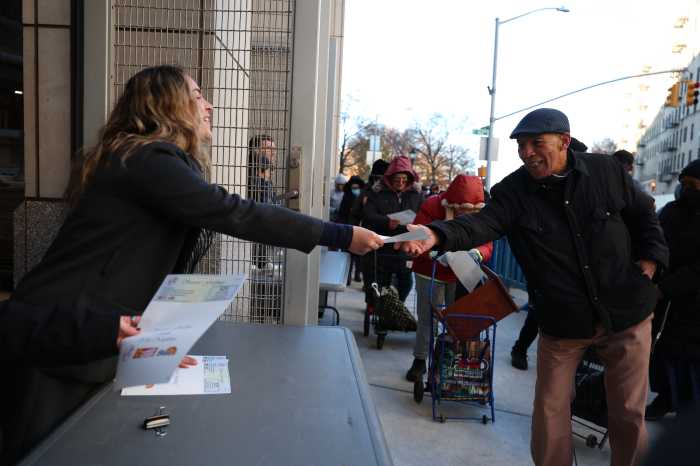Protesters heckled Governor Andrew Cuomo as he accepted the State Democratic Convention’s endorsement for reelection last month. | MIKOLA DE ROO FOR HOUSING WORKS
While Governor Andrew Cuomo and Mayor Bill de Blasio dance around harm reduction measures to reduce the record-high number of overdose deaths, Cynthia Nixon is embracing Safer Consumption Spaces at events in the city and upstate.
Cuomo’s Democratic primary challenger unequivocally supports allowing users to inject in health care facilities where overdose prevention workers can step in and reverse overdoses, while the governor and mayor approach the issue like it’s a political third rail that could destroy them.
De Blasio gave the program a yellow light; he’s for it but he wants the cover of the state health commissioner concurring. The delay there has been laid at the feet of Cuomo, who faced interruptions during his speech at the recent the State Democratic Convention by activists chanting, “End overdose deaths now!” The protesters were removed from the hall.
As Cuomo delays on de Blasio request, challenger grabs the opioid issue
The following day, State Health Commissioner Howard Zucker sent a letter to a de Blasio aide asking for more information, especially related to concerns about neighborhood objections, before he would green-light the programs in Brooklyn, Manhattan, and the Bronx — as well as upstate Ithaca, the first locality statewide to authorize such Safer Consumption Spaces.
In the meanwhile, the number of deaths keeps rising, with the latest figures for New York City reaching a new high of 1,441 in 2017, 80 percent of them from opioids. More people are dying of overdoses than from homicides, suicides, and vehicular accidents combined. This number averages out to an overdose death every seven hours in the five boroughs, a figure that explains the activists’ sense of urgency.
The governor’s hesitation was challenged this past Sunday evening during a campaign appearance Nixon made in Ithaca. Asked about the issue by a local doctor who operates a harm reduction clinic for drug users, Nixon gave Safer Consumption Spaces her enthusiastic endorsement.
“If we can show it’s successful here,” the Ithaca Journal reported her saying, “it will explode across the country and save thousands of lives.”
The close working relationship between Cuomo and Charles King, the CEO of Housing Works, the AIDS services organization that has pushed the Safer Consumption Space issue hard, has become strained over the governor’s failure to approve the plans in the city and in Ithaca.
“I’ve always praised the governor when he did the right thing, but I don’t have any reservations about calling him out when he falls short,” King said in a telephone interview.
He added that a personal conversation he had with Zucker convinced him that the health commissioner is on board.
Indeed, in his May 25 response to a de Blasio aide, Zucker wrote there is “emerging evidence that SIFs” — Safer Injection Facilities, another name for Safer Consumption Spaces — have many public health benefits that would “reduce overdose fatalities, lessen public nuisance, and curtail the transmission of bloodborne infections.” In addition, these programs “help bridge marginalized and vulnerable individuals” into treatment, care, and support.
Though he termed Zucker’s queries to the de Blasio administration a bit disingenuous because the state health department knows the answers to the questions,” King added, “It’s an effort by him to buy time knowing he [Cuomo] is right in the middle of a primary election.”
Despite warnings by US Attorney General Jeff Sessions that he would move against Safer Consumption Spaces under federal “crack house statutes,” according to The Economist, advocates are convinced the state and city can act under the same provisions of the New York Public Health Law that enabled clean needle exchanges to emerge decades ago without federal authorization.
Safer Consumption Spaces are touted as effective in preventing infections, including hepatitis C and HIV, but most dramatically in curbing overdose deaths. These facilities are widely used in Canada, Europe, and Australia to permit drug users to consume drugs under the watchful eye of overdose prevention workers. Should a user go into a deep nod and lose consciousness, staff can provide oxygen or naloxone, a drug that is inhaled and quickly revives a user and restores normal breathing.
Since the first such facilities were opened in Basel, Switzerland in 1986, these facilities have handled thousands of overdoses, with not a single death reported in more than 100 sites worldwide.
It’s too soon to know the impact of Nixon’s endorsement of the program, but the questions being asked by the state health department seemingly pose few obstacles to moving forward. Zucker asked whether drivers would be allowed to use drugs — to which King tartly replied, “Of course not.” Nor will the facilities provide drugs to clients; those would have to be bought in the illegal market and carried into the Safer Consumption Space.
Zucker also posed the ultimate softball question: “What kind of care is provided after use?” This is the biggest selling point for the approach. The user stays in the center, where help is just steps away.
“If you don’t like people nodding out on a street corner,” King said, “let’s give them space to do it indoors safely.”
Editor's note: Due to an editing error, the print version of this story incorrectly stated that demonstrators were arrested at the recent State Democratic Convention. They were removed from the hall, but not arrested. Activists who demonstrated in Albany recently about this issue were arrested.

















